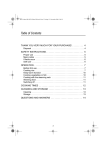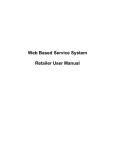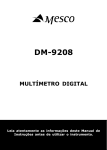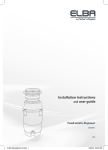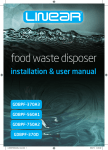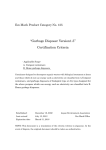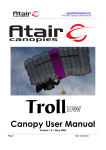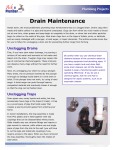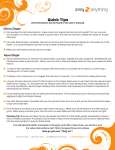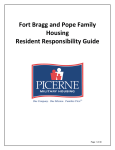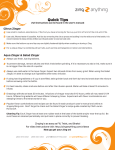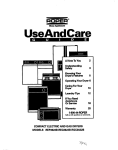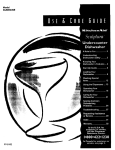Download WASTE DISPOSER OWNER`S GUIDE
Transcript
WASTE DISPOSER OWNER’S GUIDE NOTE: This Food Waste Disposer has been designed to operate on 110-120 Volt, 60 Hz exclusively. Using any other voltage or Hz adversely affects performance. IMPORTANT: Read all instructions thoroughly. Keep this guide for future reference. CAUTION: Be sure to review SAFETY INSTRUCTIONS FIRST PERTAINING TO A RISK OF FIRE, ELECTRICAL SHOCK OR INJURY TO PERSONS before using disposer. RECORD IMPORTANT DISPOSER INFORMATION HERE Bill of sale, sales slip, cancelled check or other purchase record should be kept to verify the original purchase date for warranty purposes. Model Number* Serial Number* *Above information appears on the label affixed to bottom of the disposer. For your convenience, write down the model and serial numbers prior to installation. Call our toll free Help Line with any questions 1-800-854-3229 IMPORTANT SAFETY INSTRUCTIONS INSTRUCTIONS PERTAINING TO A RISK OF FIRE, ELECTRIC SHOCK OR INJURY TO PERSONS. SAVE THESE INSTRUCTIONS. NOTE: if you are not familiar with electrical power and procedures, call a qualified electrician WARNING – Improper connection of the equipment-grounding conductor can result in a risk of electric shock. Check with a qualified electrician or serviceman if you are in doubt as to whether the appliance is properly grounded. Do not modify the plug provided with the appliance if it will not fit the outlet, have a proper outlet installed by a qualified electrician. WARNING – When using electrical appliances, basic precautions should always be followed, including the following: 1. Read all instructions before using the appliance. 7. 2. To reduce the risk of injury, close supervision is necessary when an appliance is used near children. 3. Do not put fingers or hands into a waste disposer. 4. Turn the power switch to the off position before attempting to clear a jam or remove an object from the disposer. To reduce the risk of injury by materials that may be expelled by a waste disposer, do not put the following into a disposer: clam or oyster shells; caustic drain cleaners or similar products; glass, china or plastic; large whole bones; metal, such as bottle caps, tin cans, aluminum foil or utensils; hot grease or other hot liquids; whole cornhusks. 8. When not operating a disposer, leave the stopper in place to reduce the risk of objects falling into the disposer. 5. When attempting to loosen a jam in a waste disposer, use a long wooden object such as a wooden spoon or the wooden handle of a broom or mop. 9. DO NOT operate disposer unless splash guard is in place. (Does not apply to the Top Control/Batch Feed units.) 10. For proper grounding instructions see the ELECTRICAL CONNECTION portion of this manual. 6. When attempting to remove objects from a waste disposer use long-handled tongs or pliers. If the disposer is magnetically actuated, non-magnetic tools should be used. DIMENSIONS FWD75B FWD75 FWD100 DOUBLE BOWL CENTER OUTLET / SINGLE BOWL / Direct replacement for most makes & models. Direct replacement for most makes & models. *10” Direct replacement: *10” for models WD-751 & WD-1001. • FWD75, FWD100, WD50 & WD75. *12” for models WD-751B, WD-1001B & WD-100LC. *Approx. *Approx. *12” Direct replacement: • FWD75B (Power cord optional). 2 WD50 & WD75 DOUBLE BOWL END OUTLET / *Approx. TOOLS AND MATERIALS YOU MAY NEED PHILLIPS & FLATBLADE SCREWDRIVER HAMMER HACKSAW PIPE WRENCH PLUMBER’S PUTTY DOWEL OR STEEL PUNCH DISHWASHER CONNECTOR KIT STRAIN RELIEF POWER CORD SECTION 1 - REMOVAL OF OLD UNIT TYPICAL INSTRUCTIONS, YOUR MODEL MAY VARY. Before starting this step, turn off electrical power at the circuit breaker or fuse box. If your old mount is the same as on your new disposer, just reverse the assembly instructions found in section 3. If your new mount system is different, follow these instructions: 1C A. Use a pipe wrench to disconnect drain line where it attaches to disposer discharge tube (see Figure1A). C. When disposer is removed, turn up side down and remove electrical cover plate (see Figure 1D). B. D. Use screwdriver to remove green ground wire. Remove wire nuts from black and white power wires and separate disposer wires from power cable wires. Loosen screws on cable clamp and separate cable from disposer. E. To remove remaining mount system from the sink, loosen mount screws, push mount ring up. Under it is the snap ring. Use screwdriver to pop off ring (see Figure 1E). Remove mount ring, protector ring and gasket from sink flange. Some mounts will require the unscrewing of a large ring holding the sink flange in place. Pull sink flange up through sink and clean off old putty from sink. Remove disposer from sink flange by turning mount ring to the left clockwise (see Figure 1B). If you are unable to turn the mount ring, tap on one of the extensions from the ring with a hammer. Some mounting systems have tubular extensions. Inserting a screwdriver into one tube will provide additional leverage for turning the mount ring (see Figure 1B). Some disposers may require the removal or loosening of nuts from the mount screws (see Figure 1C). Some disposers may require the removal of a clamp. Caution: Be sure to support the disposer while performing this step or it may fall when the mounting ring is disconnected from the mounting assembly. If your disposer is hard wired (metal shielded cable not utilizing a wall plug), complete steps C and D. If you utilize a plug-in cord, go on to step E. 1A 1B 1D 1E 1A 1B IMPORTANT: Unless you have a new home, this is a good time to clean out the trap and drain lines by running a drain auger or plumber’s snake before installing your new disposer. 1C 1D 1E SECTION 2 - DISHWASHER CONNECTION If you are utilizing a dishwasher, complete the following procedure. If dishwasher is not to be connected go on to section 3A -3F. A. Using a blunt instrument (steel punch or wooden dowel), knock out entire plug (see Figure 2A). Do not use a screwdriver or sharp instrument. When knockout plug falls into disposer, you may remove it 3 or simply grind it up when the disposer is used. This will not damage the disposer in any way, but may take some time to grind, over the course of several uses. B. Connect dishwasher hose using hose clamp. If hose size is different, you will need a Dishwasher Connector Kit (see Figure 2B). Make sure all plumbing connections are tight and in accordance with all plumbing codes and ordinances. Run water andcheck for leaks. 2B *AIR GAP 2A DISHWASHER HOSE KNOCK OUT PLUG DISPOSER RUBBER HOSE *Air gap may not be required for all installations. Check local plumbing codes. SECTION 3 - INSTALLATION OF MOUNTING ASSEMBLY YOUR DISPOSER COMES WITH THE FOLLOWING COMPONENTS A Stopper/ Tapón B Sink Flange/ Borde del fregadero C Fiber Gasket/ Junta de la fibra D Backup Flange/ Borde de reserva E Mounting Ring/ Anillo de montaje G H Lower Mounting Ring/ Baje el anillo de montaje Dishwasher Inlet/ Entrada del lavaplatos Disposer/ Disposer F Rubber Gasket/ Junta de goma Snap Ring/ Anillo de retención Hush Cushion® NOTE: Hush Cushion included between mounting ring and lower mounting ring. READ COMPLETELY BEFORE STARTING NOTE: Pay close attention to the order of mount assembly parts, as they have been correctly assembled by the factory. A. Disassemble the mounting assembly, as it has been shipped, by turning the sink flange until the projections align with the notches in the mount ring and allow you to pull the sink flange up and out of the remaining mount assembly. Note the sequence of these parts as they are stacked and refer to Figure 3F to identify each part. 4 MOUNT SYSTEM ILLUSTRATIONS 3F SINK STOPPER* SINK FLANGE** 1 PLUMBER’S PUTTY RIDGE 2 1 1 FIBER GASKET 3 BACKUP FLANGE 4 3A 3B MOUNTING RING 3C 5 SNAP RING 6 RUBBER GASKET 3D 3E RESET BUTTON * Batch Feed Stopper looks different than the stopper illustrated. ** Mount Assembly A. Be sure sink is clean around sump opening B. Evenly apply ½” thick rope of plumber’s putty around flange (1). See Figure 3A. C. Press flange (1) firmly into sink drain. Remove excess putty. Do not move or rotate sink flange once seated or seal may be broken. See Figure 3B. D. Insert fiber gasket (2), backup flange (3) and mounting ring (5) see Figure 3C. Hold in place while inserting snap ring (6) see Figure 3D. E. Place a weight such as the disposer on the sink flange to hold it in place. Use a towel to prevent scratching sink. Pull snap ring open and press firmly until it snaps into place. F. Tighten the 1½” screws (3) evenly and firmly against backup flange. Use shorter screws if sink is more than 3/8” thick. See Figure 3E. SECTION 4 - ELECTRICAL CONNECTIONS Now is the time to record the SERIAL NUMBER (located on the bottom of the disposer) onto the warranty card. If you are not familiar with electrical power and procedures call a qualified electrician. FOR WASTE DISPOSERS EQUIPPED WITH A GROUNDED PLUG-IN POWER CORD. This appliance must be grounded. In the event of a malfunction or breakdown, grounding provides a path of least resistance for electric current to reduce the risk of electric shock. This appliance is equipped with a cord having an equipment-grounding conductor and a grounding plug. The plug must be plugged into an appropriate outlet that is properly installed and grounded in accordance with all local codes and ordinances. WARNING: Improper connection of the equipment-grounding conductor can result in a risk of electric shock. Check with a qualified electrician or serviceman if you are in doubt as to whether the appliance is properly grounded. Do not modify the plug provided with the appliance if it will not fit the outlet, have a proper outlet installed by a qualified electrician. FOR WASTE DISPOSERS NOT EQUIPPED WITH A GROUNDED PLUG-IN POWER CORD. This appliance must be grounded. In the event of malfunction or breakdown, grounding provides a path of least resistance for electric current to reduce the risk of electric shock. The power cord (to be installed) must have an equipment-grounding conductor and a grounding plug. The plug must be plugged into an appropriate outlet that is properly installed and grounded in accordance with all local codes and ordinances. WARNING: Improper connection of the equipment-grounding conductor can result in a risk of electric shock. Check with a qualified electrician or serviceman if you are in doubt as to whether the appliance is properly grounded. 5 NOTE: Disconnect electric power to disposer circuit before installation. Turn the circuit breaker to the OFF position or remove the fuse. Wiring Disposer Directly to House Current A. Connect disposer to 110-120 Volt, 60 Hz AC current only. B. This appliance must be connected to a grounded, metal, permanent wiring system; or an equipment-grounding conductor must be run with the circuit conductors and connected to the equipment-grounding terminal or lead on the appliance. If plug-in cord is used, use a three prong plug (see Figure 4A). Ground wire should be attached to the ground screw in the bottom of the end bell (see Figure 4C). A. C. Use a cable clamp strain relief connector where power cord enters the disposer (see Figure 4B). Trace lead connected to this blade and attach that lead to white wire on disposer. RIBBED SIDE 4A NOTE: When viewing face of electical plug with grounding pin at top, the larger left blade is connected to the identified wire. 4B If BX cable is not used, provide a separate ground wire to nearest cold water metal pipe or other suitable ground, using the screw in the bottom of the end bell for the ground wire (see Figure 4C). 4C RED RESET BUTTON STRAIN RELIEF NUT B. GROUND SCREW TO HOUSE CURRENT OR POWER CORD If you use BX cable: 1. Install cable connector in hole. 2. Connect white wire to white lead of disposer. 3. Connect black. 4. Connect bare ground. WIRE NUTS REMOVE COVER PLATE If your power supply does not include a ground wire, you must provide one unless metal cable is used. Attach a copper wire securely to disposer ground screw and attach other end of wire to a metal cold water pipe. Use only UL approved ground clamp. If plastic pipe is used in your home, a qualified electrician should install a proper ground. SECTION 5 - ATTACHING DISCHARGE ELBOW A. Connect elbow to the disposer (see Figure 5A), proceed to section 6 and then connect bottom of the elbow by tightening the slip nut (see Figure 5B). B. If you are connecting to a dishwasher, return to section 2B. If not, make sure all plumbing connections are tight and in accordance with all plumbing codes and ordinances. Run water and RUBBER GASKET 5A 5B 5B SECTION 6 - CONNECTING DISPOSER TO MOUNT ASSEMBLY D. If you need to turn the disposer make sure the sink flange does not turn. It will break the seal created when installed. Go back to steps 5A and 5B. A. Press firmly around the Hush Cushion® to ensure it is engaged with the neck of the disposer. B. Lubricate the top inside lip of the rubber Hush Cushion® with a liquid soap. C. 6A 6B Line up discharge elbow of disposer with trap under mounting assembly. Guide disposer up and engage the GROOVE of the Hush Cushion® around the RIDGE at the bottom of the sink flange (see Figure 6A. While still supporting the disposer, tighten the screw-clamp around Hush Cushion®. The disposer will now hang by itself. 6 6B SECTION 7 - OPERATING INSTRUCTIONS The Anti-Jam Swivel Impellers make a clicking sound as they swing into place. This indicates normal operation. A. Remove sink stopper. Turn on a medium flow of cold water. B. Turn switch to ON position; your motor is turning at full speed and ready to use. C. Scrape in food waste. Down the drain go table scraps, peelings, rinds, seeds, pits, small bones and coffee grounds. To speed up food waste disposal, cut or break up large bones, rinds and cobs. Large bones and fibrous husks require considerable grinding time and are more easily thrown away with other trash. Do not be alarmed that the disposer slows down while grinding. The disposer is actually increasing torque (grinding power) and is operating under normal conditions. D. Before turning disposer off, let water and disposer run for approximately 15 seconds after shredding stops. This assures that all waste is thoroughly flushed through trap and drain. E. It is not recommended to use hot water while running disposer. Cold water will keep waste and fats solid so disposer can flush away particles. BATCH FEED OPERATING INSTRUCTIONS The Anti-Jam Swivel Impellers make a clicking sound as they swing into place. This indicates normal operation. A. Remove sink stopper and turn on a medium flow of cold water. 7A B. Scrape in food waste. Down the drain go table scraps, vegetable peelings, cobs, rinds, pits, bones and coffee grounds. (see Figure 7A) C. D. Insert stopper to start disposer. (see Figure 7B) One of the two small slots in stopper base must line up with switch plunger inside the neck of the disposer. Push down firmly to turn the disposer on. Lift stopper to shut the disposer off. E. To fill sink, insert stopper and align the largest slot with the switch plunger. (see Figure 7C) Push down to seal sink without starting the disposer. When medium sized slot (see Figure 7B) in stopper base is lined up with the switch plunger, water can drain, but tableware, etc., cannot be accidentally dropped into disposer. Run disposer for 15 seconds after shredding stops. This assures that all waste is thoroughly flushed through the drain. 7B MEDIUM SLOT TIPS FOR SUCCESSFUL OPERATION 7C A. Be sure disposer is empty before using your dishwasher so it may drain properly. B. You may want to leave the stopper in the drain when not in use to prevent utensils and foreign objects from falling into the disposer. C. Your disposer is ruggedly built to give you many years of trouble free service. It will handle all normal food wastes, but it will NOT grind or dispose of such items as plastic, tin cans, bottle caps, glass, china, leather, cloth, rubber, string, clam and oyster shells, aluminum foil or feathers. SMALL SLOT LARGE SLOT 7 TROUBLESHOOTING TURNTABLE DOES NOT ROTATE FREELY: Turn off disposer, then check for any foreign object lodged between the turntable and grind ring. Dislodge object by rotating table with a wooden broom handle and remove object. (see 8B) If no foreign object is present, there may be internal problems. Before seeking repair or replacement, we recommend that you review the following: LOUD NOISES: (Other than those during grinding of small bones and fruit pits): These are usually caused by accidental entry of a spoon, bottle cap or other foreign object. To correct this, turn off electrical switch and water. After disposer has stopped, remove object with long handled tongs. LEAKS: If the unit leaks at the top, it may be due to: 1. Improper seating of sink flange (gasket centering, putty or tightening). UNIT DOES NOT START: Unplug power cord or turn either the wall switch or breaker box switch to “OFF” position, depending on your model and wiring configuration. Remove stopper and/or splash guard. Check to see if turntable will rotate freely using a wooden broom handle. If turntable rotates freely, check re-set button to see if it has been tripped. Re-set button is red and located opposite discharge elbow, near the bottom (see Figure 8A). Push button in until it clicks and remains depressed. 2. Mount ring not tightened properly. 3. Defective or improperly installed Cushion Mount®. If unit leaks at the waste elbow, leak may be due to improper tightening of elbow flange screws. 8A 8B If re-set button has not been tripped, check for shorted or broken wire connecting to disposer. Check electrical power switch, fuse box or circuit breaker. If wiring and electrical components are intact, the unit may have internal problems that require service or replacement. Call our toll free Help Line with any questions 1-800-854-3229 CLEANING AND MAINTENANCE DO NOT ATTEMPT TO LUBRICATE YOUR DISPOSER! The motor is permanently lubricated. The disposer is self cleaning and scours its internal parts with each use. NEVER put lye or chemical drain cleaners into the disposer, as they cause serious corrosion of metal parts. If used, resulting damage can be easily detected and all warranties are void. Mineral deposits from your water can form on the stainless steel turntable, giving the appearance of rust. DO NOT BE ALARMED, the stainless steel turntables used will not corrode. WARRANTY • Full 10 Year In-Home Service Warranty on Models FWD75 and FWD75. sure fuses and circuit breakers are in good order. Reread instruction booklet to assure that you are using correct operating procedure (see section 8). Many unnecessary service calls result in the service man doing what the owners can do for themselves. • Full 5 Year In-Home Service Warranty on Models WD75 and WD50. • Limited Lifetime In-Home Service Warranty on Model WD100. • FRANKE, INC. In-Home Service Warranty. Covers all replacement parts and repair labor to correct defects in material or workmanship for the full warranty period from the date of installation in your home. If service is required during the warranty period, a FRANKE Factory Authorized Service Center must be contacted to replace or repair the disposer in the customer’s home at no charge to the customer. If the manufacturer determines the unit should be replaced rather than repaired, the warranty on the replacement will be limited to the unexpired term of the original warranty. 2. Check with your local authorized service center. For the location of your nearest factory authorized service center call the toll free numbers listed above. 3. Write to us if a satisfactory solution is not reached in steps 1 and 2. Our address is: FRANKE SERVICE DEPARTMENT 2680 Orbiter Street, Brea, CA 92821 • Lifetime Corrosion Warranty. In addition to above warranty, FRANKE disposers that fail to operate as a result of corrosion will be repaired or replaced by FRANKE, INC. Parts or disposer will be provided to repair or replace the subject disposer. Costs of service labor for installation will be borne by the owner. This Lifetime Corrosion warranty is limited to the original purchaser. Original sales receipt is required. 4. Write MACAP. MACAP is a group of independent consumer experts voicing views at the highest levels of the major appliance industry. MACAP receives comments and complaints from appliance owners, studies industry practices and advises industry of ways to improve its service to consumers. Write to the following address: MAJOR APPLIANCE CONSUMER ACTION PANEL 20 North Wacker Drive, Chicago, IL 60606 • How To Obtain Service. If you have questions concerning your disposer, or when service is needed, please call FRANKE’S Customer Service Information Center at 1-800-854-3229 for the nearest FRANKE Factory Authorized Service Center. model number and serial number of your disposer, date purchased, dealer from whom purchased (include address), service agency names and address, location of appliance and clearly describe problem and service required. Give the following information: date, your name, address and telephone number, • No Other Express Warranty, Written or Oral, Applies. NOTE: No separate warranty registration card is enclosed. Warranty is determined by unit serial number or date of installation. Record installation date here. Purchase or installation receipt may be required to verify status. If your disposer will not operate, follow these steps, in order: 1. Check the things you can do yourself. Be sure disposer is plugged firmly into appropriate receptacle or is properly electrically connected in some other manner. Be 560C417P02 REV B 8










